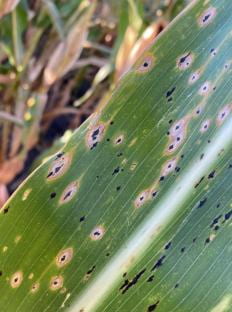 Written by Ed Lentz, ANR Educator, Hancock County
Written by Ed Lentz, ANR Educator, Hancock County
Drivers may see the recognizable triangular orange symbol warning drivers of slow-moving vehicles in the area for the next two to four weeks as farmers gear up for crop planting. The emblem is required on farm vehicles moving less than 25 miles per hour and horse-drawn vehicles. What you may not know is that Ohio was an agricultural leader in the development of this SMV emblem.
In the late 1950s, two researchers in the Department of Agricultural Engineering of Ohio State University, Walter McClure and Ben Lamp, completed a 10-year retrospective study of fatal tractor accidents to understand the nature and causes of highway tractor collisions. They found a significant number of fatalities related to highway travel by slow-moving vehicles. Ohio State Highway Patrol, county sheriffs, and municipal police cooperated in a later study by gathering detailed data on 708 slow-moving vehicle accidents and estimated that 65% of the motor vehicle accidents involving slow-moving vehicles were rear-ended collisions. Continue reading Agriculture icon celebrates 60 years
 Are you planning on spreading mulch around your trees and landscape this year? Master Gardener Volunteers see this common practice of mulch placed under trees and right up the tree trunk!
Are you planning on spreading mulch around your trees and landscape this year? Master Gardener Volunteers see this common practice of mulch placed under trees and right up the tree trunk!
 For most agricultural producers, activities over the winter months tend to slow down. This is an opportune time to take a look at your farming operation and determine if there are areas that could benefit from the establishment of one or more conservation practices.
For most agricultural producers, activities over the winter months tend to slow down. This is an opportune time to take a look at your farming operation and determine if there are areas that could benefit from the establishment of one or more conservation practices.
 The Paulding County Farm Service would like to remind our conservation participants, that once you have successfully completed your CRP practice and gathered all bills, receipts, and seed tags to submit these to FSA for cost share reimbursement. Make sure there is an itemized bill for all components listed on your CRP Conservation Plan. If any of the work was done by yourself, include a bill for work completed, time to complete, and cost.
The Paulding County Farm Service would like to remind our conservation participants, that once you have successfully completed your CRP practice and gathered all bills, receipts, and seed tags to submit these to FSA for cost share reimbursement. Make sure there is an itemized bill for all components listed on your CRP Conservation Plan. If any of the work was done by yourself, include a bill for work completed, time to complete, and cost. Maps are now available at the Paulding County FSA Office for 2023 acreage reporting purposes. FSA staff have mailed maps to the operator on each farm. If you do not receive your 2023 maps in the mail, please contact our office or email us at
Maps are now available at the Paulding County FSA Office for 2023 acreage reporting purposes. FSA staff have mailed maps to the operator on each farm. If you do not receive your 2023 maps in the mail, please contact our office or email us at 